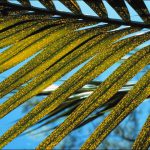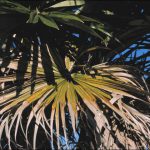 Potassium deficiency could be the most widespread of all palm nutrient deficiencies. Symptoms of potassium (K) deficiency can vary among palm species, but always appears first on the oldest leaves. Some palms are mottled with yellowish spots that are translucent when viewed from below. In other palms, symptoms appear as marginal or tip necrosis with little or no yellowish spotting present or marginal or tip necrosis appearing withered and frizzled. Potassium deficiency can cause older palm leaves to drop prematurely. In severe cases, the canopy will contain only a few leaves, all of which will be chlorotic, frizzled and stunted. The trunk will begin to taper (pencil-pointing) and death of the palm often follows.Potassium deficiency is caused by insufficient K in the soil, but can be induced or accentuated by high Nitrogen:Potassium or Calcium:Potassium ratios in the soil. It is very common on palms grown in highly leached sandy soils that have very low cation exchange capacities.
Potassium deficiency could be the most widespread of all palm nutrient deficiencies. Symptoms of potassium (K) deficiency can vary among palm species, but always appears first on the oldest leaves. Some palms are mottled with yellowish spots that are translucent when viewed from below. In other palms, symptoms appear as marginal or tip necrosis with little or no yellowish spotting present or marginal or tip necrosis appearing withered and frizzled. Potassium deficiency can cause older palm leaves to drop prematurely. In severe cases, the canopy will contain only a few leaves, all of which will be chlorotic, frizzled and stunted. The trunk will begin to taper (pencil-pointing) and death of the palm often follows.Potassium deficiency is caused by insufficient K in the soil, but can be induced or accentuated by high Nitrogen:Potassium or Calcium:Potassium ratios in the soil. It is very common on palms grown in highly leached sandy soils that have very low cation exchange capacities.
Visual symptoms alone may be sufficient for diagnosis of potassium deficiency, although leaf nutrient  analysis may be helpful in distinguishing a late stage deficiency from manganese (Mn) deficiency. These two deficiencies can be extremely similar from a distance, but close examination should reveal characteristic spotting and marginal necrosis in K deficiency or necrotic streaking for Mn deficiency. Potassium deficiency symptoms are also more severe toward the leaf tip and are less so at the leaf base. The reverse is true for Mn deficiency.
analysis may be helpful in distinguishing a late stage deficiency from manganese (Mn) deficiency. These two deficiencies can be extremely similar from a distance, but close examination should reveal characteristic spotting and marginal necrosis in K deficiency or necrotic streaking for Mn deficiency. Potassium deficiency symptoms are also more severe toward the leaf tip and are less so at the leaf base. The reverse is true for Mn deficiency.
Regular applications of potassium fertilizers will prevent K deficiency and treat palms already deficient. On sandy soils, or those having little cation exchange capacity, controlled-release K sources are much more effective than water-soluble K sources. Sulfur-coated potassium sulfate has been shown to be the most effective and economical source for K in the landscape. When applying K fertilizers to correct an existing K deficiency, it is important to also apply about 1/3 as much Mg (also in a slow release form such as prilled kieserite) to prevent a high K:Mg ratio from causing an Mg deficiency problem.
For severely K-deficient landscape palms, broadcast this 3:1 blend of sulfur-coated potassium sulfate and prilled kieserite uniformly to the soil under the canopy at a rate of 1.5 lbs per 100 sq ft of canopy area. This should be repeated in three months. Three and six months after that, a 1:1 mixture of the K:Mg blend and a balanced 8-2-12+4Mg palm maintenance fertilizer should be similarly applied at the rate of 1.5 lbs of fertilizer per 100 sq ft of canopy area, bed area, or entire landscape area. After one year, use only the 8-2-12+4Mg with micronutrients maintenance fertilizer at the above rate.
For mild to moderately K-deficient palms, application of the 8-2-12+4Mg palm maintenance fertilizer every 3 months should be sufficient to treat and prevent K deficiencies. Treatment of K deficient palms may require one to two years or longer, since the entire canopy of the palm may need to be replaced with new symptom-free leaves. Removal of discolored older K-deficient leaves on a regular basis has been shown to accelerate the rate of decline from this disorder and can result in premature death of the palm.
Read more: http://edis.ifas.ufl.edu/ep269
See also Fertilization of Field-grown and Landscape Palms in Florida http://edis.ifas.ufl.edu/ep261 and Nutrition and Fertilization of Palms in Containers http://edis.ifas.ufl.edu/ep262.
 0
0
